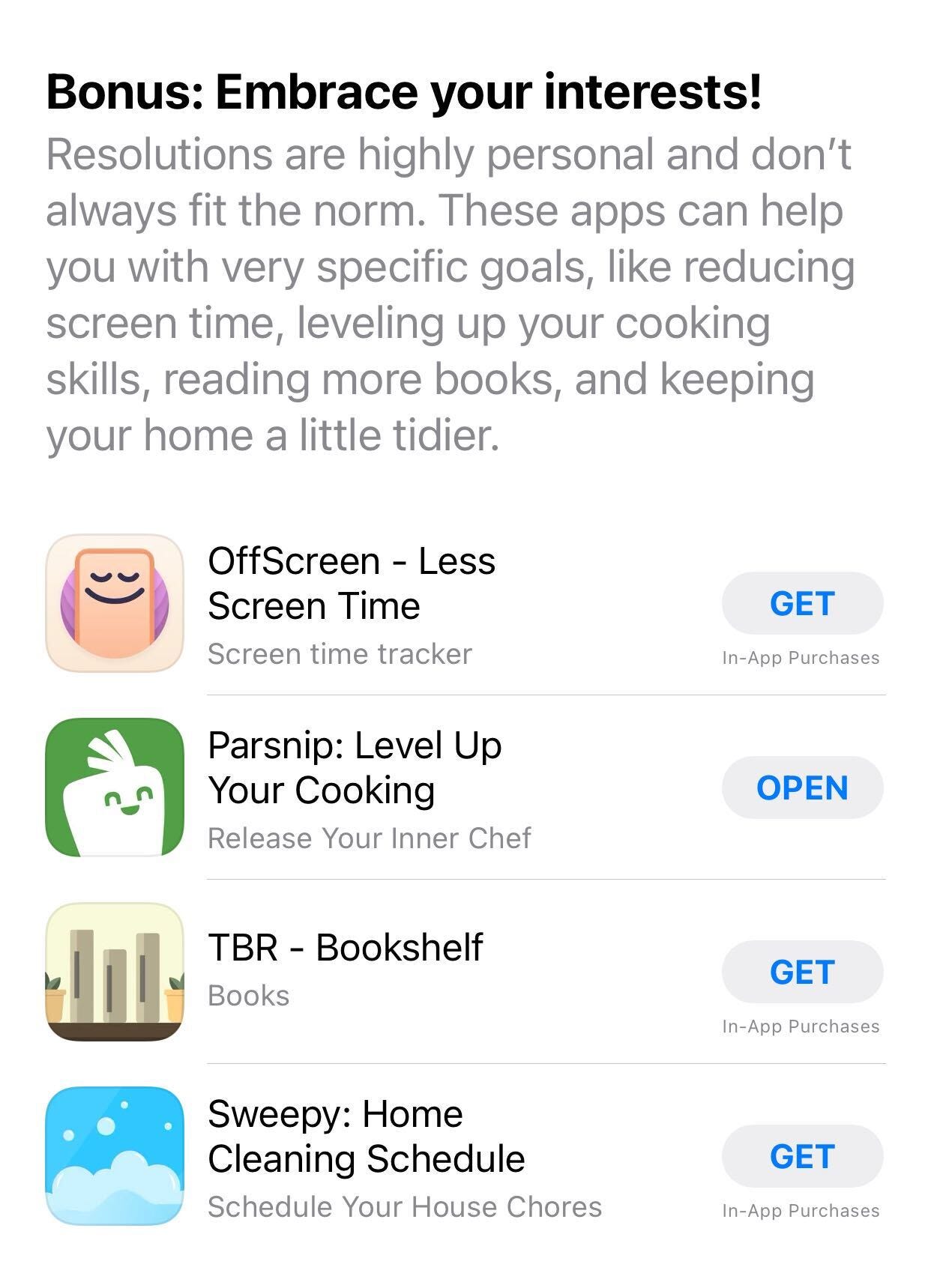New year, new generative AI 🤯
Using ChatGPT and LLMs to accelerate Parsnip
Happy new year to you, and Parsnip! This week, Apple featured Parsnip among apps that help you start and keep your New Year’s resolutions:
This has garnered us the most weekly installs we’ve ever had—over 3,500 and counting. Since launch 6 months ago, Parsnip stands at a total of
21,521 downloads,
4,465 accounts created,
168,936 levels completed, and
1,161,586 questions answered,
…all without paid marketing. If you haven’t tried Parsnip yet, now’s a great time!
ChatGPT: is it hype or revolution?
Over the last month, you’ve probably seen the waves that OpenAI’s ChatGPT demo has made on the Internet. In many ways, it has epitomized the famous quote:
Any sufficiently advanced technology is indistinguishable from magic.
— Arthur C. Clarke
But while ChatGPT feels amazing in many ways, it can also fail on seemingly simple problems. Because under the hood, it’s just assigning probabilities to sequences of strings based on all the data it’s seen—albeit reams and unimaginable reams of data, producing what seems like magic at scale.
At the risk of being a bit reductive, ChatGPT is particularly good at:
retrieving information that it’s been trained on
But at the same time, it’s not very strong at:
solving problems involving logic
building models of the world
It turns out humans still have an advantage there—for now.
So, how does this help Parsnip?
ChatGPT has been trained on publicly available data from the Internet—and much of that data is about food. So naturally, it knows a lot about cooking. Combining this with its rewriting abilities, we’ve been able to create content for Parsnip about 6 times faster than before.
Here’s how that works: if you take a look at multiple-choice questions on Parsnip, you’ll see that there are 4 plausible answers, each with a humorous food pun and an informative “explainer”. These take a great deal of time, effort, and research to write at the quality we’re looking for.
ChatGPT can spit these out like no one’s business. The responses still need editing and fact-checking, but this process vastly speeds up the initial content generation and research. In fact, Ben and Anderson (our content team) have already created over 35 AI-assisted levels in the last 3 weeks, bringing us to a total of over 150 levels1 in Parsnip.
It can also help us scaffold our tech tree and see what components we’re missing. This is particularly helpful to make sure that our content is comprehensive for any dish we’re trying to teach, and that we’re not overlooking anything important.
In the future, we envision a particularly powerful personalized cooking helper that can be embodied in Snippy. For example, load up ChatGPT with any recipe and you can ask it context-specific questions:

In early ideation for Parsnip we considered an “Uber for cooking help” where chefs would be available on demand to answer any cooking question. This technology provides that ability instantly, at any time, and at close to zero cost.
A common theme among many beginner cooks we’ve talked to is the struggle with confidence, knowing where to start, and lack of understanding of the how or why behind recipes. At the same time, many are afraid of making mistakes or “asking dumb questions”. Now, anyone can ask as many questions as they want without fear of failure or judgment, building confidence along the way.
LLMs are a power tool for cooking and education
The technology underlying ChatGPT is the Large Language Model (LLM). LLMs will be transformative for many industries, but they’re particularly powerful for the application of cooking & education.
First, any machine learning model is only as useful as the data it’s trained on. So while ChatGPT can’t match the knowledge of domain experts on esoteric topics, it knows a ton about food—because it has access to almost all cooking knowledge available on the Internet. Second, this knowledge is immediately useful off-the-shelf: while other applications of LLMs need to be further trained with domain-specific knowledge, cooking and food have been around for eons and the basic principles haven’t changed.
In 1970, the economist Herbert Simon predicted that when information becomes abundant, attention becomes the scarce resource. And this is precisely what’s happened with cooking knowledge: just because it’s widely available doesn’t mean it’s any more accessible, and beginner cooks struggle mightily with getting started. While we might live in an age of information, many people are in the dark ages of cooking.
Parsnip’s goal has to make the knowledge of cooking—a core life skill that we can use daily—more readily accessible and available. And the more we build, the more we see that there’s an eager market of users who deeply desire to be better cooks. The technology of LLMs just accelerates our mission further.
For now, we’re using ChatGPT to generate content almost an order of magnitude faster, into a format that is both effective for teaching and that we know our users like. But in the future, we’re excited to embody Snippy with an interactive AI that helps any aspiring cook build their knowledge and confidence.
Or if you liked this post, share it with a friend:
We estimate that our tech tree will only need about 500 levels to teach 80% of the core knowledge for all US-centric cooking. Read more about that here:








Hey Andrew, this is a crisp description of your LLM use cases at Parsnip and the tech seems really impactful. I’m curious how you are managing content moderation (given there is a lot of food related content that can be triggering in the general corpus) and if you will set policies for LLM use. Might be interesting for future posts
Dianne Na Penn